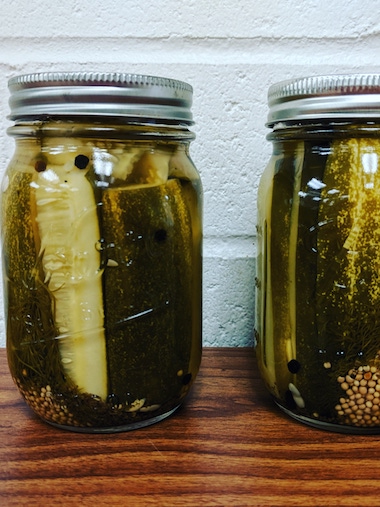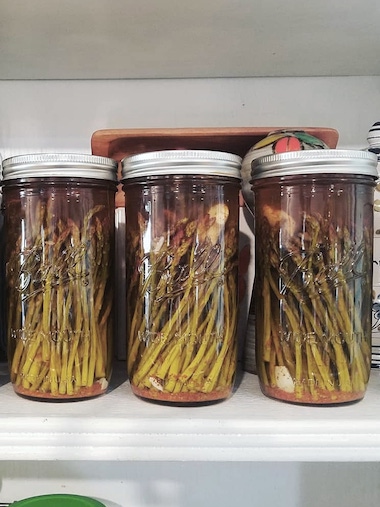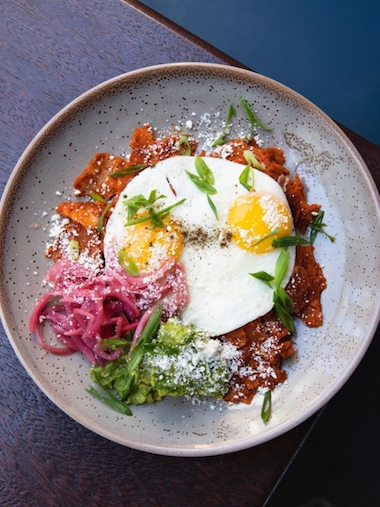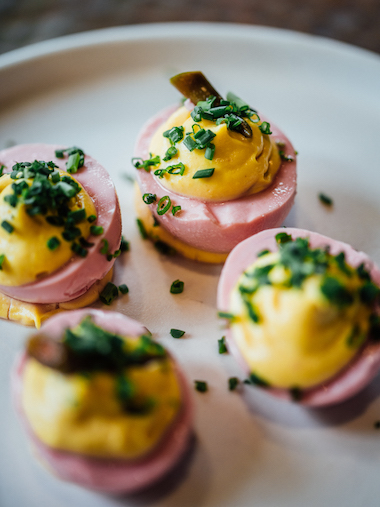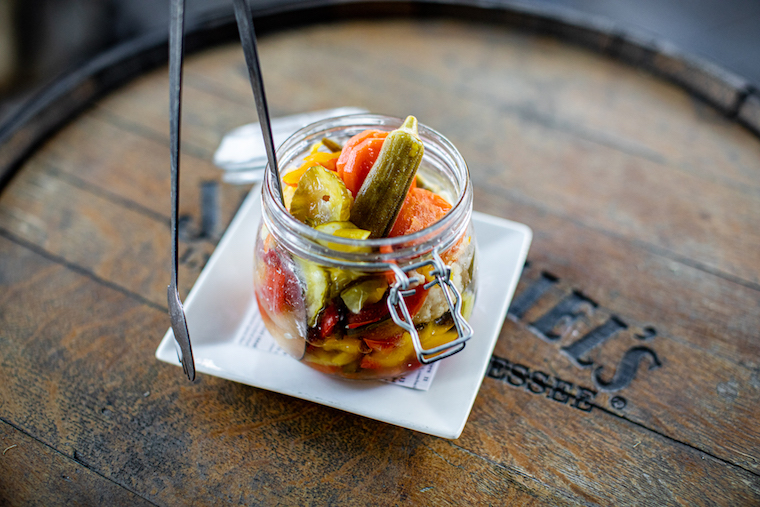
Delve into the world of food preservation by creating tasty snacks at home or enjoying them at local eateries.
By Ashley Ryan
From Peter Piper’s search for pickled peppers to the tradition of hiding a Christmas pickle on the tree each year, there’s no doubt that this preservation process has impacted life in America. For decades, pickled goods have been placed atop hamburgers, used as a garnish for sandwiches and made into tartar sauces or relishes.
The rise in the popularity of pickling didn’t start during the pandemic; it has been on that trajectory for the last few years. However, with many people confined to their homes over the last year, the trend has been gathering even more steam. It’s cheap and easy to do, it doesn’t require any hard-to-find materials and it offers an air of creativity that housebound locals can enjoy while waiting for the world to fully open up again. And as popularity continues to grow, restaurants are pickling all sorts of vegetables and incorporating them in local menus.
According to a 2020 study by Research and Markets, one of the largest market research companies in the world, the trend isn’t stopping anytime soon, with a projected growth of more than 3% in the next five years. Though the study reveals that pickle demand is likely to increase around the globe, it names North America as the continuous market leader.
Here, we’ll share tips on how and why to pickle items in the comfort of your own home, as well as detail where you can find some of these savory options around town.
Precise Pickling
This process of preserving food is not a new one by any means. In fact, it dates back as far as 2000 B.C., to ancient Mesopotamia, but pickles were also popular as a supposed beauty secret when Cleopatra reigned and are even mentioned in the Bible. And not much has changed since then, as far as the process goes.
According to Colleen Clemens, program coordinator for the University of California Cooperative Extension Master Food Preservers of Orange County, part of a nationwide food safety effort by the U.S. Department of Agriculture that is certified by the UC system, the most common type of pickling uses vinegar. “The acetic acid in vinegar is naturally antibacterial, so it kills or inhibits most foodborne bacteria and, thus, slows down food spoilage,” she explains. “Small amounts of salt and/or sugar are usually added to the vinegar brine, which also help inhibit bacterial growth.”
This nonheat process allows people to create their own pickles at home, and all that is needed is the food to be pickled, a jar, the pickling solution and a refrigerator. The process kills any bacteria on the food or the jar, which is important because she says bacteria can still exist in microscopic amounts no matter how much the item is washed.
“The acid also slowly begins to break apart the cells of the food, which is why, eventually, pickles will lose their crisp texture and become mushy,” Clemens notes. “Refrigeration slows this process.”
The other type of pickling, which is done through fermentation, uses lactic acid rather than acetic acid. During the fermentation process, Clemens says picklers are actually cultivating lactobacillus, a probiotic that can be beneficial to the digestive system. “The ‘good’ bacteria slowly eat the food that is being fermented, and one of the byproducts of their metabolizing is lactic acid, which begins to have the same effect as acetic acid,” she explains. “Once you have fermented to the point where you like the taste, you put the ferment in the refrigerator, and this slows the ferment[ation].”
However, Clemens warns that fermentation has more potential risks than vinegar pickling does. “It’s important to understand the science and facts [behind the processes],” she adds.
As mentioned, pickling isn’t a new technique and, Clemens believes, like many other hobbies, its popularity is cyclical. “Things seem to fall out of style and then come back in again when a new generation ‘discovers’ an old tradition and puts their own twist on it,” she says. “For home picklers, the pandemic has created a burst of interest and enthusiasm in both home vegetable gardening and how to preserve what has been grown. Refrigerator pickling and fermenting are relatively easy, low-equipment preservation methods.”
According to Clemens, most vegetables and fruits are suitable for pickling, as well as things like eggs and even pig’s feet. In order to get started, she recommends using a vinegar that has been acidified to 5%—if the vinegar is too sweet or mild, it may have too little acid to be effective. Once the process is complete, Clemens says that refrigerated pickled products can last for months. However, foods that were soft or overripe when the process started will go mushy faster.
“Food preservation can be easy and delicious, but long-term food storage does have safety concerns to be aware of,” Clemens says, noting that the UCCE Master Food Preservers website, ucanr.edu/sites/MFPOC, offers tips for preserving safely and successfully. It also offers free recipes and an email help line where an expert can answer specific questions.
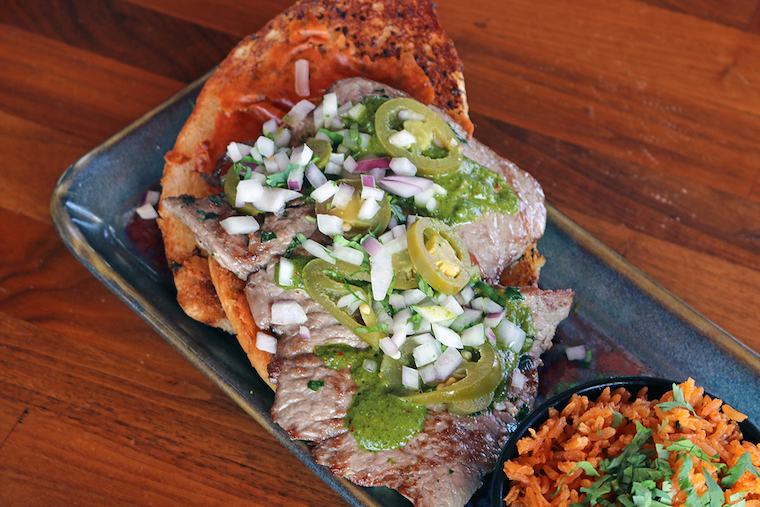
Newport Novelties
A number of eateries around town have incorporated pickled items into their menus, giving locals a chance to explore their flavors and textures before venturing into the world of home pickling.
At Bosscat Kitchen & Libations, the Pickles & Vegetables starter is the perfect introduction, with a seasonal assortment of produce pickled in-house. Current offerings include traditional cucumbers—also known simply as pickles—in addition to okra, cauliflower and various bell peppers. Served in a small glass jar, the presentation is just as spectacular as the flavor.
“Our pickling process is done using a quick pickling method,” says Peter Petro, chef/partner at Bosscat. “It is done by making a brine, boiling [it] and pouring it over the vegetables. We allow them to cool and hold them under refrigeration.” Petro says they use this method because they consider it to be safer for guests than the fermentation method.
In addition to the starter, pickled vegetables can be found on the menu at Bosscat on the ahi tuna wraps, the Bosscat Burger and the BC Press sandwich, which features pulled pork and ham. Spicy pickles are also placed atop the protein in the crispy fried chicken sandwich. And, during brunch on the weekends, the Bosscat Bloody Mary typically includes the pickled okra as well.
When it comes to Mexican cuisine, pickled jalapenos are a staple that can be incorporated into various dishes. At Sol Mexican Cocina, these pickled peppers are made in-house using another prominent cultural ingredient: tequila.
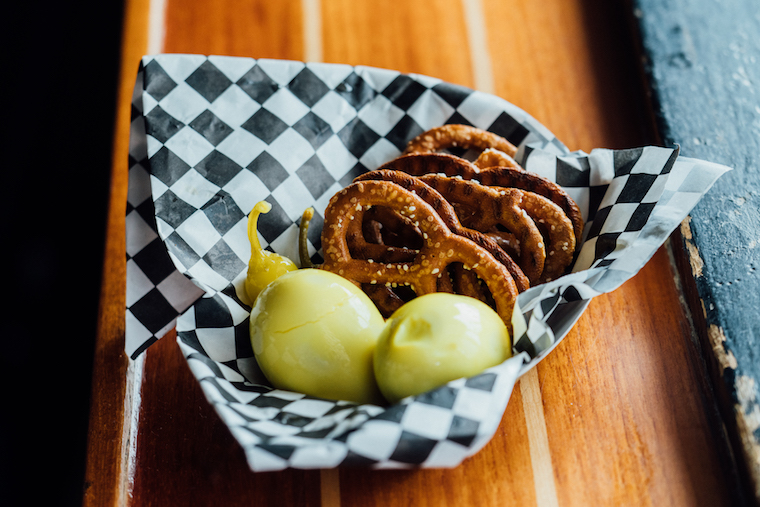
“We pour a mixture of vinegar, water, garlic, tequila, Mexican oregano and other Mexican spices over jalapenos,” says Michael Gaines, food and beverage director for Xperience Restaurant Group, which includes Sol. “… The tequila-pickled jalapeno is spicy, acidic and crunchy, which helps to add texture and cuts through the savory profile of items like tacos and carnitas. The pickled jalapenos are also served cold, which adds a refreshing layer to the entire dish.”
When dining at Sol, go for lunch or brunch, as it’s those menus where you’ll find the pickled jalapenos. As part of the carne asada torta, the jalapenos accompany steak, onions, lettuce, pico de gallo, guacamole and a chipotle sauce, while the rib-eye “quesotorta” pairs them with seared rib-eye steak brushed with garlic butter, crispy browned cheese and a flavorful chimichurri sauce. During weekend brunch, they’re incorporated into the chile verde eggs, a dish that features a smoky stew with green sauce, and jalapeno cornbread; a whole pickled jalapeno is served on the side.
Locals can also try a more rare find: pickled eggs. At Blackie’s by the Sea, a beach bar located near the Newport Beach Pier, the staff has been pickling eggs since 1953. “The recipe is unique as they come and has been a closely guarded secret … ever since conception,” says Steve Darden, the bar’s manager. “… Only four people over the span of 70 years have had it.”
The pickling process takes place off-site, where they are able to make 450 pickled eggs per batch. It takes about five hours to prep, boil and peel the eggs and start the pickling process. Once the eggs are ready, they are served at Blackie’s with pretzels and a yellow chile pepper.
Helmsman Ale House also serves pickled eggs, though they look a little different. After pickling in a brine of beet juice, Champagne vinegar, Thai and serrano chiles, smashed garlic, black peppercorn and coriander, the yolks of the pickled eggs are used to make those of the deviled variety. In addition to the yolks, Helmsman uses mayonnaise, Dijon mustard, paprika and some other spices to give the mixture a bit of a kick, and the deviled eggs are served with four halves in each order.
In addition, the chilaquiles on the weekend breakfast menu feature another pickled item. “Pickled red onions provide a sharp contrast to the savory tones of our guajillo chile sauce,” says Troy Barton, captain at Helmsman. “The sharp sour notes end up complementing the overall flavor with the citrus-forward pickling brine we [use]. … We also add the same onions on our short rib chili omelet; they just play well with rich meats and sauces.”
Barton nods to the probiotic benefits and electrolytes in pickled goods as one reason the team was interested in creating them, but also says the workers love fermentation—since they’re at a brewery—and know how to use it to make tasty food. “From time to time, we try different brines for pickled vegetables,” he notes. “Over the summer, we … made our own spicy pickles for our summer Santa Maria-style barbecue on the weekends in our beer garden.”
And, with so many restaurants around town opting to try out this technique, Barton says that he’s been excited to explore the culinary trend. “I think that people are enjoying being a bit more adventurous with their food choices lately, which has given way to more kitchens like ours, where we … try and find new, fun ways of incorporating these great pickled flavors into the menus.”


